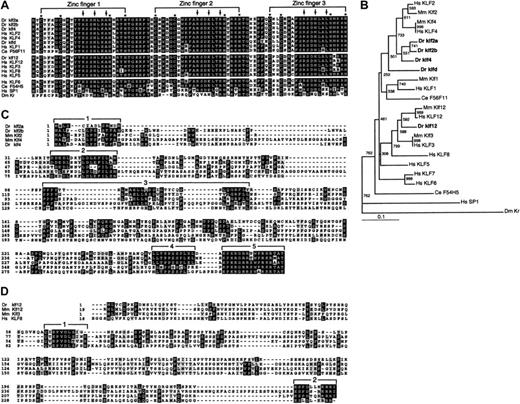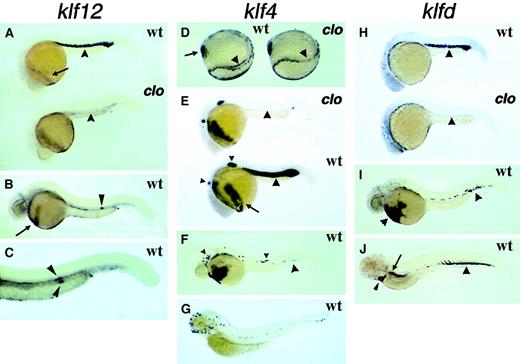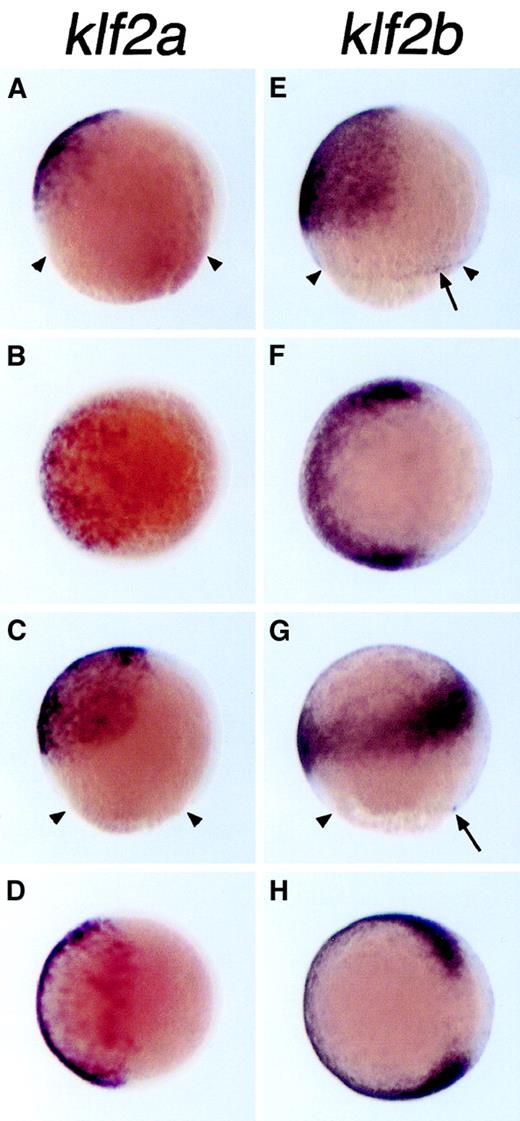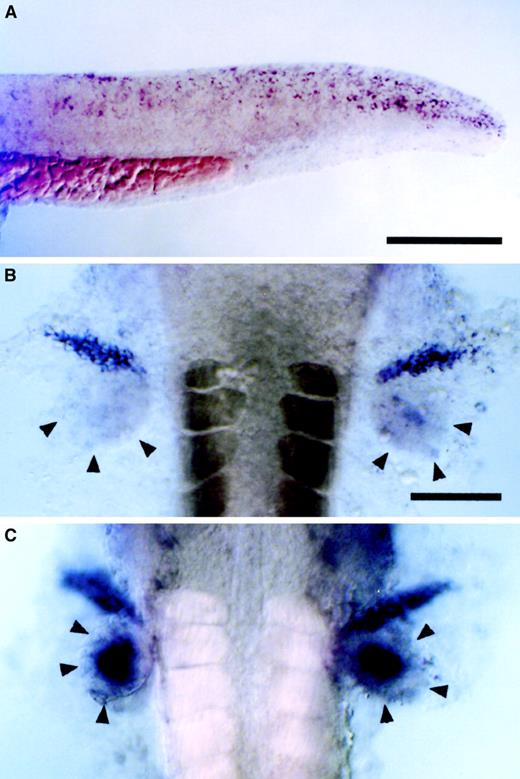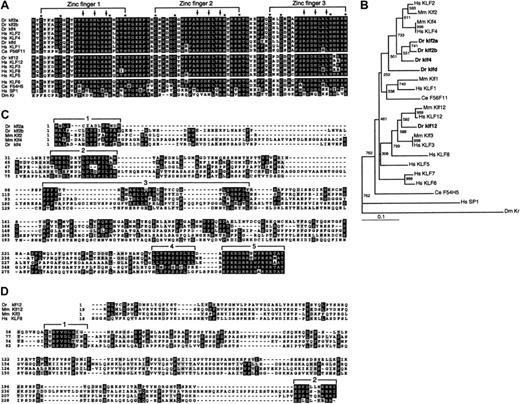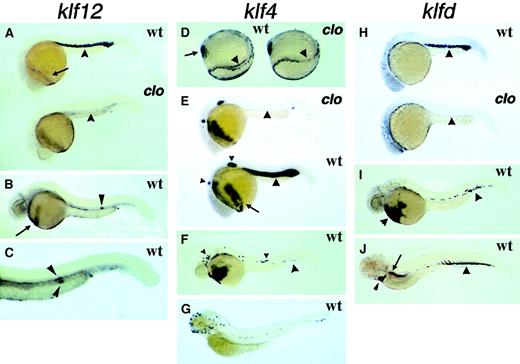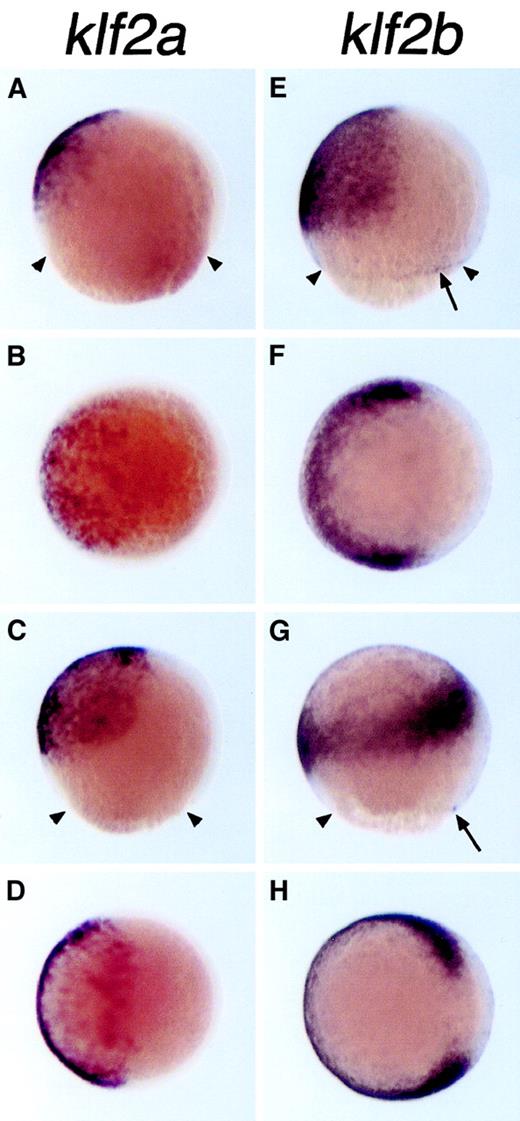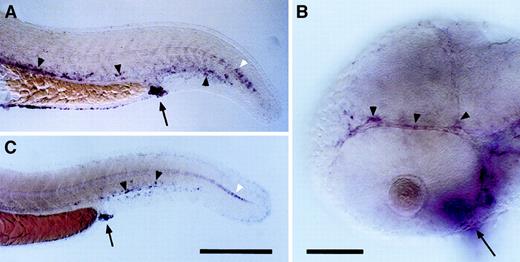Abstract
The Krüppel-like factor(KLF) family of genes encodes transcriptional regulatory proteins that play roles in differentiation of a diverse set of cells in mammals. For instance, the founding memberKLF1 (also known as EKLF) is required for normal globin production in mammals. Five new KLF genes have been isolated from the zebrafish, Danio rerio, and the structure of their products, their genetic map positions, and their expression during development of the zebrafish have been characterized. Three genes closely related to mammalian KLF2 andKLF4 were found, as was an ortholog of mammalianKLF12. A fifth gene, apparently missing from the genome of mammals and closely related to KLF1 and KLF2,was also identified. Analysis demonstrated the existence of novel conserved domains in the N-termini of these proteins. Developmental expression patterns suggest potential roles for these zebrafish genes in diverse processes, including hematopoiesis, blood vessel function, and fin and epidermal development. The studies imply a high degree of functional conservation of the zebrafish genes with their mammalian homologs. These findings further the understanding of theKLF genes in vertebrate development and indicate an ancient role in hematopoiesis for the Krüppel-like factorgene family.
Introduction
The Krüppel gene ofDrosophila is required for the correct formation of the embryonic body plan through its activity as a transcriptional repressor.1-3 Members of the Krüppel-like factor (KLF) gene family have been discovered in mammals; they are expressed in a wide variety of tissues and encode both transcriptional activator and repressor proteins.4Recent targeted-deletion experiments in mice have revealed roles for members of the KLF family in erythroid cell maturation,5,6 T-cell activation,7 and blood vessel stability,8 as well as skin permeability.9 These results indicate that the mammalianKLF gene family plays an important role in the control of hematopoietic and other cell type differentiation.
Although the DNA-binding activity of the highly conserved, C-terminal zinc finger domain of KLF proteins is clear, the function of diverged, N-terminal structures remains under investigation. Membership in the KLF family is defined by the presence of 3 tandem zinc finger motifs at the C-terminus of the protein with a F/Y-X-C-X2-4-C-X3-F-X5-L-X2-H-X-R/K-X-H consensus that are connected by a characteristic linker: T/S-G-E-R/K-P.10 This domain confers sequence-specific DNA binding to GC-rich elements of the general structure CCN CNC CCN,11 such as the CACCC-box,12-16 and in vitro site selection has suggested the consensus sequence NNR CRC CYY.17 The N-termini of KLF proteins are highly variable, and several are characterized by the presence of domains with transcriptional activator and/or repressor functions in vitro.14-16,18-23 In addition, the N-terminus of some KLF proteins contains sites of phosphorylation and acetylation that may contribute to regulation of KLF activity.24 25Despite these studies, it remains an important task to identify functionally significant sites in KLF protein N-termini. Zebrafish is sufficiently diverged from mammals that amino acid sites unimportant for protein function will have diverged, leaving functionally important sites as islands of sequence conservation. Thus, the isolation of zebrafish homologs of the mammalian KLF genes and comparison of the N-terminal regions would allow the demarcation and functional testing of evolutionarily conserved domains.
Loss of Klf1 (erythroid Krüppel-like factor,EKLF) gene function in mice results in a lethal β-thallassemia.6,26 To determine whether any of the hypochromic, thalassemialike phenotypes seen in zebrafish27,28 might be the result of a lesion in a homolog of the Klf1 gene, we have isolated related members of the KLF gene family from the zebrafish and determined their structure, chromosomal position, and expression during embryogenesis. The isolation of novel zebrafish klf genes may point to the existence of previously unsuspected mammalian orthologs, and their expression patterns in the developing fish may help to understand more rapidly the estimated 300 zinc finger–containing genes in the human genome.29 We found that 3 of the 5 zebrafish klf genes are expressed in the developing hematopoietic system and another is expressed in developing vasculature, suggesting an ancient evolutionary role for theKLF gene family in generation of the blood.
Materials and methods
Isolation of zebrafish klf cDNA
To isolate zebrafish klf cDNAs, a 1120-bpBamHI/NcoI fragment from the mouseKlf1 cDNA clone12 was hybridized to 5.0 × 105 plaques of an adult zebrafish kidney cDNA library in pBK-CMV using standard techniques. More than 80 positive clones were originally isolated, and 32 were examined more extensively by sequencing. Recently, the Human Gene Nomenclature Committee has standardized the naming of this gene family. We will use the new gene names in this article, but supply the old name of a gene where it appears first in the text. Gene accession numbers of the klfcDNA sequences are as follows: klf2a,AF392992;klf2b,AF392995; klf4,AF392994; klfd,AF392996; klf12,AF392993.
Phylogenetic analysis
Alignment of sequences was performed using the ClustalX near neighbor joining algorithm,30 31 with some adjustment by eye. Sequence accession numbers of the KLF genes used in these analyses are as follows: Hs KLF1,U37106; Mm Klf1,AF033102; Hs KLF2, NM_006075; Mm Klf2,U25096; Hs KLF3, NM_016531; Mm Klf3,U36340;Hs KLF4,O43474; Mm Klf4,U70662; Hs KLF5,Q13887; Hs KLF6,U44975; Hs KLF7,AF001461; Hs KLF8, NP_009181; Hs KLF12,NP_009180; Mm Klf12,Y14295; Hs SP1,P08047;Ce F56F11,AF099922; Ce F54H5,U80952; andDm Krüppel,AAF47321; where Hs,Mm, Ce, and Dm stand forHomo sapiens, Mus musculus,Caenorhabditis elegans, and Drosophila melanogaster, respectively.
Phylograms were built using the output.dnd and .phb files from ClustalX in Treeview PPC.70
Genetic mapping
In situ hybridization
Results
To isolate the Klf1 homolog in zebrafish, we hybridized a fragment of the cDNA of mouse Klf112 to a zebrafish adult kidney cDNA library because the kidney is the site of definitive hematopoiesis in the zebrafish. Sequence analysis of 32 positive clones demonstrated that these cDNAs represented 5 independent genes, each containing Krüppel-like zinc finger motifs. In 4 cases, the assignment of probable orthologies required information from both protein phylogeny and chromosomal localization (see below, klf2a, klf2b, klf4,and klf12). For the fifth gene, these data suggested that no ortholog exists in modern mammalian genomes, and this gene is designated klfd, consistent with zebrafish nomenclature procedures.
Phylogenetic and structural analysis of zebrafishklf genes
In an amino acid comparison with other KLF family members, the C-terminal regions of the 5 zebrafish genes were highly conserved (Figure 1A), consisting of 3 tandem zinc fingers. However, the regions outside the finger domain strongly diverged and cannot be reliably aligned across the entireKLF family. Of 83 amino acid positions in the conserved zinc finger domain, only 19 were phylogenetically informative, which limits the resolution of phylogenetic reconstruction. A probable phylogeny of this gene family based on the relations between the zinc finger domains is presented in Figure 1B.
Evolutionary relations between the zebrafishKrüppel-like factor (KLF) genes and those from other species.
(A) Amino acid alignment of the C-terminal zinc finger domains of zebrafish KLF proteins with selected vertebrate KLF proteins andDrosophila KRUPPEL. Amino acid identity is marked with black and similarity with gray highlighting. Asterisks mark the invariant zinc-chelating residues, and the arrows indicate those residues that contact the DNA. (B) Phylogenetic tree of the evolutionary relation of zebrafish KLF genes to their close vertebrate relatives andDrosophila Krüppel, based on the sequences of the zinc finger domains of the respective proteins. Numbers give the bootstrap support for given nodes in the phylogram. (C) Amino acid alignment, excluding the zinc finger domain, of the N-termini of zebrafish Klf2a, Klf2b, and Klf4 proteins with their closest vertebrate relatives Klf2 (Lklf) and Klf4 (Gklf). Regions of high similarity are numbered and indicated with brackets; see text for details. (D) Amino acid alignment, excluding the zinc finger domain, of the N-termini of zebrafish Klf12 protein with its close vertebrate relatives Klf3 (Bklf) and Klf12 (AP-2rep). Regions of high similarity are numbered and indicated with brackets; see text for details.
Evolutionary relations between the zebrafishKrüppel-like factor (KLF) genes and those from other species.
(A) Amino acid alignment of the C-terminal zinc finger domains of zebrafish KLF proteins with selected vertebrate KLF proteins andDrosophila KRUPPEL. Amino acid identity is marked with black and similarity with gray highlighting. Asterisks mark the invariant zinc-chelating residues, and the arrows indicate those residues that contact the DNA. (B) Phylogenetic tree of the evolutionary relation of zebrafish KLF genes to their close vertebrate relatives andDrosophila Krüppel, based on the sequences of the zinc finger domains of the respective proteins. Numbers give the bootstrap support for given nodes in the phylogram. (C) Amino acid alignment, excluding the zinc finger domain, of the N-termini of zebrafish Klf2a, Klf2b, and Klf4 proteins with their closest vertebrate relatives Klf2 (Lklf) and Klf4 (Gklf). Regions of high similarity are numbered and indicated with brackets; see text for details. (D) Amino acid alignment, excluding the zinc finger domain, of the N-termini of zebrafish Klf12 protein with its close vertebrate relatives Klf3 (Bklf) and Klf12 (AP-2rep). Regions of high similarity are numbered and indicated with brackets; see text for details.
Zebrafish Klf2a, Klf2b, and Klf4 proteins were most similar to mammalian Klf2 (lung Krüppel-like factor, Lklf38) and Klf4 (gut Krüppel-like factor, Gklf39) (Figure1B,C). They were more closely related to each other than to either Klf2 or Klf4, however, although low bootstrap values precluded the assignment of direct orthologies to either of these mammalian genes on the basis of sequence alone. Examination of an amino acid alignment of the N-termini of this group of proteins revealed 5 highly conserved blocks of residues separated by divergent regions (numbered brackets in Figure 1C). These are potentially functional domains and include (1) the N-terminal–most 16 amino acids, (2) an acidic domain (D20 to T37 [single-letter amino acid code] of Klf2a), (3) a proline-rich domain (P75 to R106), and (4) a conserved block (F218 to D246) immediately N-terminal to (5) a basic domain (K254 to R266).
The Klf12 protein was more similar to mouse Klf12 (AP2-rep) and human KLF12 than to any other protein, including the closely related KLF3/Klf3 (BKLF/Bklf) and KLF8, which together form a clade (Figure1B). Thus, it appears that zebrafish klf12 is the ortholog of the mammalian KLF12 genes (Figure 1B,D). Comparison of the amino acid sequences of the N-termini of these proteins revealed that they are less conserved than those of the KLF2/4 subfamily, with 2 regions of high similarity (indicated with brackets and numbers in Figure 1D): (1) from Q65 to K75 of Klf12, and (2) another cluster immediately N-terminal to the zinc finger domain (E221 to I242).
Although klfd was placed at the base of theKLF2/4 subfamily by virtue of its zinc finger domain, it lies close to the stem of the Klf1-Klf2/4 divergence in Figure 1B. We note that the bootstrap replication values for the nodes in the tree at this point were sufficiently low to regard this placement as unresolved with respect to membership in theKlf1 or Klf2/4 family. To place these putatively novel zebrafish klf genes more precisely in the evolutionary history of the KLF family, we determined their chromosomal positions and potential syntenic relations to mammalian chromosomes.
Genetic mapping of klf family members
Each of the klf genes was genetically mapped to the zebrafish genome (Table 1).klfd, klf12, klf2b, and klf4were analyzed by meiotic mapping on the MOP-cross DNA panel.32-34 Both klf2b and klf4 are found on linkage group 2 (LG2), whereas klf12 is found on LG1 and klfd on LG6. klf2a was mapped using a radiation hybrid panel,35 placing it on LG22. None of these positions correspond to the 6 published hematopoietic mutant positions: sauternes,40weissherbst,41dracula,42yquem,43riesling,44 orspadetail.45
The orthology assignments of the zebrafish klf genes based on amino acid sequences were reassessed and refined using information about syntenic chromosomal regions between fish and mammals34 46-48 and are described in Table 1. This analysis will be presented in depth elsewhere (manuscript in preparation), but is beyond the scope of the current report. The syntenic relations between the chromosomes containing the zebrafishklf2a, klf2b, and klf4 genes and their closest known mammalian homologs provide support for the notion thatklf2a and klf2b are collectively orthologous toKLF2 and that klf4 is orthologous to the mammalian KLF4 gene. The syntenic relations between the chromosomes containing klf12 and human KLF12support the phylogenetic analysis showing that these genes are likely orthologous. Finally, klfd is found in a chromosomal region that shares conserved synteny with both Klf1 andKlf2 genes in mammals. Although sequence analysis indicates that klfd does not have a known ortholog in mammalian genomes, it is most closely related to Klf1 andKlf2 (Figure 1B). Combined, these data suggest thatklfd may be related to an ancestor of these genes.
Expression of the klf genes during development
While the structural comparisons, phylogenetic analyses and conserved syntenies presented above argue gene histories, expression analysis can reveal potential developmental properties of the zebrafish klf genes. The expression of each of theklf genes reported here was determined during embryonic and larval stages by whole-mount in situ hybridization.
klf12, klf4, and klfd expression patterns
klf12, klf4, and klfd were characterized by high-level expression in the hematopoietic system, as illustrated in Figure 2. Transcripts from each of these genes were detected in a line of cells immediately below the notochord along the ventral aspect of the trunk at 24 hours past fertilization (hpf) (Figure 2A,E,H). This region is known as the intermediate cell mass (ICM) and is the site of primitive erythropoiesis.49 The pattern of expression along the anterior/posterior axis was similar to that seen with erythrocyte markers gata1,50,51jak2,37 and embryonicglobins40,52 and did not extend into the posterior tail as seen with the stem cell markerscl,53 consistent with expression in primitive erythrocytes. To confirm that the signal was produced in hematopoietic cells, we assayed the expression of each of these genes in thecloche mutant background, which exhibits a profound defect in the hematopoietic and vascular lineages.54-56 Staining was absent from the ICM in one quarter of embryos in clutches fromcloche+/− parents (Figure 2A,E,H; Figure3D), verifying a hematopoietic site of expression for klf12, klf4, and klfd. Expression of klf4 and klfd in circulating primitive erythrocytes was detected at 48 hpf (Figure 2F,I), whereas expression of klf12 in these cells was absent by this time (Figure 2B). Only klfd expression was detected in definitive hematopoietic cells. By 8 days past fertilization (dpf), transcripts were detected in the site of definitive hematopoiesis, the pronephros, and in circulating definitive erythrocytes in the heart lumen and vessels of the tail (Figure 2J).
Expression of the klf12, klf4, and klfd genes in the zebrafish embryo.
Whole-mount in situ hybridization of zebrafish embryos with riboprobes for the zebrafish klf12 gene (A-C), klf4 (D-G), and klfd (H-J). Embryos are shown in lateral view, oriented with anterior to the left and dorsal up, except in panel D, where embryos are viewed obliquely from the posterior, with anterior to the top and dorsal to the right. (A-C) Expression of klf12. (A) Comparison of wild-type (wt, upper) and cloche mutant animals (clo, lower) at 24 hours past fertilization (hpf), showing the absence of klf12 expression in the intermediate cell mass (ICM, arrowheads) of clo embryos and klf12expression in hatching gland cells across the yolk (arrow). (B) Expression at 36 hpf showing hatching gland (arrow) and pronephric duct cell clusters (arrowhead). (C) Higher magnification and oblique view of animal in panel B, showing bilateral nature of pronephric duct cell clusters (arrowheads). (D-G) Expression of klf4. (D) Comparison of wt (left) and clo mutant (right) at 12 hpf in an oblique view, showing the absence of a row ofklf4-expressing blood cells in the posterior lateral plate mesoderm (arrowheads) and the position of the polster (arrow). (E) Comparison of wt (lower) and clo mutant animals (upper) at 24 hpf, showing the absence of klf4 expression in the ICM (arrowheads) of clo embryos and klf4 expression in hatching gland cells (arrow). Small arrowheads mark the primordia of the anterior and posterior lateral line ganglia. (F) At 48 hpf, circulating erythrocytes expressing klf4 are visible across the anterior of the yolk and in the vessels of the tail (arrowhead). The anterior and posterior extents of the migrating lateral line primordia are marked with small arrowheads. (G) Larva at 4 days past fertilization (dpf) showing klf4 expression in complete lateral line system. (H-J) Expression of klfd. (H) Comparison of wt (upper) and clo mutant animals (lower) at 24 hpf, showing the absence of klfd expression in the ICM (arrowheads) of clo embryos. (I) Embryo at 48 hpf showingklfd expression within circulating erythrocytes on anterior yolk and in trunk and tail vessels (arrowheads). (J) Larva at 8 dpf showing klfd expression in circulating definitive erythrocytes in tail vessels (arrowhead), heart lumen (small arrowhead), and pronephros (arrow). Original magnification 50 ×; stained with nitroblue tetrazolium chloride (NBT) and S-bromo-4-chloro-3-indolylphosphate p-toluidine salt (BCIP) precipitate.
Expression of the klf12, klf4, and klfd genes in the zebrafish embryo.
Whole-mount in situ hybridization of zebrafish embryos with riboprobes for the zebrafish klf12 gene (A-C), klf4 (D-G), and klfd (H-J). Embryos are shown in lateral view, oriented with anterior to the left and dorsal up, except in panel D, where embryos are viewed obliquely from the posterior, with anterior to the top and dorsal to the right. (A-C) Expression of klf12. (A) Comparison of wild-type (wt, upper) and cloche mutant animals (clo, lower) at 24 hours past fertilization (hpf), showing the absence of klf12 expression in the intermediate cell mass (ICM, arrowheads) of clo embryos and klf12expression in hatching gland cells across the yolk (arrow). (B) Expression at 36 hpf showing hatching gland (arrow) and pronephric duct cell clusters (arrowhead). (C) Higher magnification and oblique view of animal in panel B, showing bilateral nature of pronephric duct cell clusters (arrowheads). (D-G) Expression of klf4. (D) Comparison of wt (left) and clo mutant (right) at 12 hpf in an oblique view, showing the absence of a row ofklf4-expressing blood cells in the posterior lateral plate mesoderm (arrowheads) and the position of the polster (arrow). (E) Comparison of wt (lower) and clo mutant animals (upper) at 24 hpf, showing the absence of klf4 expression in the ICM (arrowheads) of clo embryos and klf4 expression in hatching gland cells (arrow). Small arrowheads mark the primordia of the anterior and posterior lateral line ganglia. (F) At 48 hpf, circulating erythrocytes expressing klf4 are visible across the anterior of the yolk and in the vessels of the tail (arrowhead). The anterior and posterior extents of the migrating lateral line primordia are marked with small arrowheads. (G) Larva at 4 days past fertilization (dpf) showing klf4 expression in complete lateral line system. (H-J) Expression of klfd. (H) Comparison of wt (upper) and clo mutant animals (lower) at 24 hpf, showing the absence of klfd expression in the ICM (arrowheads) of clo embryos. (I) Embryo at 48 hpf showingklfd expression within circulating erythrocytes on anterior yolk and in trunk and tail vessels (arrowheads). (J) Larva at 8 dpf showing klfd expression in circulating definitive erythrocytes in tail vessels (arrowhead), heart lumen (small arrowhead), and pronephros (arrow). Original magnification 50 ×; stained with nitroblue tetrazolium chloride (NBT) and S-bromo-4-chloro-3-indolylphosphate p-toluidine salt (BCIP) precipitate.
Expression of klf2aand klf2b in the zebrafish gastrula.
Whole-mount in situ hybridization of zebrafish embryos with riboprobes for the zebrafish klf2a (A-D) and klf2b genes (E-H). The embryos are shown in lateral view (A,E,C,G) with animal pole to the top and dorsal to the right, and in animal pole view (B,F,D,H) with dorsal to the right. Embryos in panels A, B, E, and F are at 70% epiboly and those in C, D, G, and H are at 90% epiboly. The gastrula margin is indicated with small arrowheads (A,E,C,G), and theklf2b-expressing cells on this margin are indicated with an arrow (E,G). Original magnification 50 ×; stained with NBT/BCIP precipitate.
Expression of klf2aand klf2b in the zebrafish gastrula.
Whole-mount in situ hybridization of zebrafish embryos with riboprobes for the zebrafish klf2a (A-D) and klf2b genes (E-H). The embryos are shown in lateral view (A,E,C,G) with animal pole to the top and dorsal to the right, and in animal pole view (B,F,D,H) with dorsal to the right. Embryos in panels A, B, E, and F are at 70% epiboly and those in C, D, G, and H are at 90% epiboly. The gastrula margin is indicated with small arrowheads (A,E,C,G), and theklf2b-expressing cells on this margin are indicated with an arrow (E,G). Original magnification 50 ×; stained with NBT/BCIP precipitate.
The cells of the hatching gland expressed both klf12 andklf4 at 24 to 36 hpf (Figure 2A,B,E), an organ derived from the prechordal plate mesoderm, or polster, which also showed high levels of klf4 at 12 hpf (Figure 2D). By 36 hpf,klf12 was also detected in cells of the pronephric duct, being at highest levels in 2 bilaterally symmetrical clusters of cells of unknown identity at an axial position level with somite 14 (Figure2B,C). At 24 hpf, klf4 was present in 2 paired cell clusters lateral to the hindbrain (Figure 2E), consistent with the location of the cranial ganglia of the anterior and posterior lateral line.57 This was confirmed by observations at 36 hpf ofklf4 expression in the migrating lateral line primordia and in the clusters of neuromast cells deposited in its wake (Figure 2F). By 4 dpf, the full array of lateral line organs was marked byklf4 expression (Figure 2G).
klf2a and klf2b expression patterns
The closely related klf2a and klf2b genes were expressed during gastrula stages in the early epidermis in a distinctive, partially overlapping pattern (Figure 3). Beginning at approximately 70% epiboly, klf2a transcripts were detected in the ventral, animal portion of the epiblast (Figure 3A,B), and as epiboly progressed, this expression domain extended vegetally (Figure3C,D). At 70% epiboly, klf2b was also expressed in the ventral, animal portion of the epiblast, but in a more extensive domain than klf2a (Figure 3E,F), extending further across the gastrula both dorsally and vegetally. In addition, a thin line of cells along the dorsal margin also expressed this gene. By the end of epiboly, klf2b expression was lost in the animal-most one third of the epiblast and was expressed at higher levels in a lateral band extending around all but the dorsal midline of the embryo (Figure3G,H). Thus, the domain of klf2a expression in the epiblast was nested concentrically within the domain of klf2bexpression. klf2b expression was maintained in the dorsal marginal cells.
klf2a expression was detected at 24 hpf in the anus and in small clusters of superficial cells lateral to the most posterior notochord (Figure 4A), as well as in scattered cells closely associated with the axial and head vessels and in the heart (Figure 4A,B). These expression patterns persisted until 48 hpf, and at this time a faint signal was detected from the distal margin of the caudal fin and in the pectoral fins (Figure 4C; also see below).
Expression of klf2a in the pharyngula-stage zebrafish embryo.
Whole-mount in situ hybridization of zebrafish embryos with riboprobe for the zebrafish klf2a gene. Embryos are shown in lateral view with anterior to the left and dorsal up. Scale bars are 100 μm (A,C) and 50 μm (B). (A) Trunk and tail of a 24-hour post-fertilization (hpf) embryo showing klf2a expression in cells closely associated with the axial vessels (black arrowheads), the anus (arrow), and superficial cell clusters (white arrowhead). (B) Head of a 24-hpf embryo showing klf2a expression in head vessels (arrowheads) and heart (arrow, out of plane of focus). (C) Trunk and tail of a 36-hpf embryo showing klf2a expression denoted as in panel A. Original magnification in panels A and C 100 ×, panel B 200 ×; stained with NBT/BCIP precipitate.
Expression of klf2a in the pharyngula-stage zebrafish embryo.
Whole-mount in situ hybridization of zebrafish embryos with riboprobe for the zebrafish klf2a gene. Embryos are shown in lateral view with anterior to the left and dorsal up. Scale bars are 100 μm (A,C) and 50 μm (B). (A) Trunk and tail of a 24-hour post-fertilization (hpf) embryo showing klf2a expression in cells closely associated with the axial vessels (black arrowheads), the anus (arrow), and superficial cell clusters (white arrowhead). (B) Head of a 24-hpf embryo showing klf2a expression in head vessels (arrowheads) and heart (arrow, out of plane of focus). (C) Trunk and tail of a 36-hpf embryo showing klf2a expression denoted as in panel A. Original magnification in panels A and C 100 ×, panel B 200 ×; stained with NBT/BCIP precipitate.
klf2b was expressed in the superficial layer of the epidermis in large squamous cells more populous dorsally (Figure5A). At 36 hpf, this expression was dramatically decreased; klf2b transcripts at high level were instead present in 2 cords of cells in the body wall immediately anterior and ventral to the pectoral fin buds (Figure 5B). By 48 hpf, the mesenchymal interior of each fin bud expressed klf2bstrongly (Figure 5C).
Expression of klf2bin the pharyngula and hatching stages of the zebrafish embryo.
Whole-mount in situ hybridization of zebrafish embryos with riboprobe for the zebrafish klf2b gene. Embryo in panel A is viewed laterally with anterior to the left and dorsal up; embryos in panels B-C are viewed from the dorsal aspect with anterior up. Scale bars are 100 μm (A) and 50 μm (B-C). (A) Embryo at 24 hours past fertilization (hpf) showing klf2b expression in squamous cells of the epidermis. (B) Embryo at 36 hpf at the axial level of the anterior trunk (somites are visible as dark blocks) showing bilateralklf2b-expressing cords of cells extending laterally from anterior margin of the pectoral fin bud (arrowheads). (C) Embryo at 48 hpf viewed as in panel B, showing expression of klf2b in center of pectoral fin bud. Original magnification in panel A 100 ×, panels B and C 200 ×; stained with NBT/BCIP precipitate.
Expression of klf2bin the pharyngula and hatching stages of the zebrafish embryo.
Whole-mount in situ hybridization of zebrafish embryos with riboprobe for the zebrafish klf2b gene. Embryo in panel A is viewed laterally with anterior to the left and dorsal up; embryos in panels B-C are viewed from the dorsal aspect with anterior up. Scale bars are 100 μm (A) and 50 μm (B-C). (A) Embryo at 24 hours past fertilization (hpf) showing klf2b expression in squamous cells of the epidermis. (B) Embryo at 36 hpf at the axial level of the anterior trunk (somites are visible as dark blocks) showing bilateralklf2b-expressing cords of cells extending laterally from anterior margin of the pectoral fin bud (arrowheads). (C) Embryo at 48 hpf viewed as in panel B, showing expression of klf2b in center of pectoral fin bud. Original magnification in panel A 100 ×, panels B and C 200 ×; stained with NBT/BCIP precipitate.
Both klf2a and klf2b were expressed in a dynamic manner in the developing pectoral fins; the klf2b riboprobe gave a clearer and more intense signal, but we could not otherwise distinguish between the 2 patterns in the limb. The expression ofklf2b is illustrated in Figure6 from 2 until 5 dpf. At 2 dpf,klf2b is expressed in the mesenchymal interior of the fin bud (Figure 6A). By 3 dpf, expression had decreased in the proximal portion of the fin concomitant with the emergence of striated muscle (Figure 6B), but was maintained in the distal portion of the mesenchymal part of the fin. Expression was confined to a thin row of cells at the distal tip of the striated muscles at 4 dpf (Figure6C), and by 5 dpf, klf2b was found only in scattered epidermal cells over the fin (Figure 6D).
Expression of klf2b in the developing pectoral fins of the zebrafish.
Whole-mount in situ hybridization of dissected zebrafish pectoral fins with riboprobe for the zebrafish klf2b gene. Fins are shown with distal up and anterior margin to the left; scale bar is 50 μm. (A) klf2b is expressed in the central mesenchymal region of the fin bud at 2 days past fertilization (dpf). (B) Expression is restricted to distal positions of the fin bud at 3 dpf. (C) At 4 dpf, a narrow row of klf2b-expressing cells lines the distal end of the muscular compartment of the fin (arrowheads). (D) By 5 dpf, only scattered cells in the overlying epidermis expressklf2b (arrows). Original magnification 200 ×; stained with NBT/BCIP precipitate.
Expression of klf2b in the developing pectoral fins of the zebrafish.
Whole-mount in situ hybridization of dissected zebrafish pectoral fins with riboprobe for the zebrafish klf2b gene. Fins are shown with distal up and anterior margin to the left; scale bar is 50 μm. (A) klf2b is expressed in the central mesenchymal region of the fin bud at 2 days past fertilization (dpf). (B) Expression is restricted to distal positions of the fin bud at 3 dpf. (C) At 4 dpf, a narrow row of klf2b-expressing cells lines the distal end of the muscular compartment of the fin (arrowheads). (D) By 5 dpf, only scattered cells in the overlying epidermis expressklf2b (arrows). Original magnification 200 ×; stained with NBT/BCIP precipitate.
Discussion
In this report, we characterize KLF gene family members from a nonmammalian vertebrate. The sequences, genetic map positions, and developmental expression patterns of 5 new KLF genes represent an opportunity to analyze the evolution of the roles played by this gene family in vertebrate development.
Potential structural domains in the N-termini of the KLF family proteins
In contrast to the highly conserved C-termini of theKLF family, which contain 3 tandem DNA-binding zinc fingers, the N-termini are significantly diverged.4 Determination of activator and repressor functions in the N-termini of KLF proteins has required the generation of extensive deletion series through these regions.14-16,18-23 Our finding of domains of high amino acid sequence conservation between zebrafish and mammalian KLF proteins offers the possibility of guiding these searches and potentially extending them to detect previously unsuspected activities. We have delineated 5 regions of high sequence conservation in the N-terminus of Klf2/4 subfamily proteins. Three of these correspond to domains previously defined to possess activities essential for transcription factor function in mouse and human KLF4. Domain 2 is an acidic domain conferring transcriptional activation via the recruitment of p300/CBP15,23; domain 3 is a proline-rich domain containing sequences required for transcriptional repression by KLF415; and domain 5 is a basic nuclear localization signal.58 The function of the 2 novel conservation domains, including the N-terminal–most 16 amino acids and the conserved block immediately N-terminal to the potential nuclear localization signal, is currently unknown.
Similarly, the alignment between zebrafish Klf12 and its closest mammalian relatives revealed 2 domains of high sequence conservation N-terminal to the zinc fingers: (1) a region that includes the mCtBP2 interaction domain as defined for Klf3,22 and (2) a short block neighboring the DNA-binding domain. This subfamily does not appear to possess the extended basic sequence immediately N-terminal to the zinc finger domain seen in the KLF2/4 group, and we speculate that this short C-terminal homology domain may confer nuclear localization instead.
The N-terminus of Klfd was sufficiently diverged from the members of the KLF2/4 and KLF1 families to preclude a meaningful assessment of blocks of conserved amino acid similarity.
Thus, we have identified 7 conserved domains in the N-termini of KLF2/4 and KLF3/12/8 family proteins. The close correspondence between those domains previously defined by functional testing in cell culture and those identified by evolutionary conservation suggests that the 3 novel conserved domains we have defined by comparison between zebrafish and mammalian KLF proteins may also possess important conserved functions. The differential conservation of residues within these blocks likely reflects requirements for specific amino acids in their functions. These domains would make suitable target sequences for deletion analysis or use in a yeast 2-hybrid experiment,59 for example; and because members of both protein groups are expressed in hematopoietic cells, these domains may therefore allow the characterization of previously unrecognized activities important in hematopoiesis.
Comparison of developmental expression patterns of zebrafishklf genes with mammalian KLF genes
The mRNA expression patterns of the zebrafish klf genes not only suggest possible functions for these genes in the development of zebrafish, but, by comparison with the expression patterns and loss-of-function phenotypes of their murine homologs, also reveal the likely expression patterns of ancestral vertebrate KLFgenes. To date, loss-of-function phenotypes are known only for theKlf1, Klf2, and Klf4 genes of mice.
Removing Klf1 function in the mouse results in a lethal β-thalassemia because of inability to complete the switch from embryonic γ-globin to adult β-globin, indicating thatKlf1 is required for adult erythropoietic differentiation.6,26 We did not find a unique zebrafish ortholog of the mammalian KLF1 gene, despite our success in isolating several closely related sequences from an adult kidney library. This may be because the ortholog of KLF1 has been lost from the zebrafish genome or because the regulatory regions of a surviving KLF1 gene are mutated such that it is no longer expressed in developing definitive erythrocytes, and hence would not be found in the adult zebrafish kidney, the source of our cDNA library. Nevertheless, a role in the development of the primitive wave of erythropoiesis in zebrafish would be predicted for klf4,klf12, and klfd on the basis of their expression patterns, although these genes are not closely related. In addition, the expression of klfd in the definitive wave of hematopoiesis marks this gene as only the fourth so far identified in this process in the zebrafish, along withscl,53gata1,60 andjak2a.37 The characterization of the definitive wave of hematopoiesis in the zebrafish, although currently lagging behind that of the primitive wave, will be of great interest for genetic studies of stem cells and their behavior. The conservation of hematopoietic expression patterns we have identified suggests that a vertebrate KLF gene ancestral to the clades containingklf4, klf12, and klfd was expressed in the primitive erythropoietic lineage. The existence of other mammalianKLF genes with erythrocytic expression from these clades, such as Klf3 and Klf8,13,16 and from other clades61 62 is consistent with this expression pattern as an ancestral character for vertebrate KLF genes.
Additional roles can be postulated for klf4 andklf12 in the development of the hatching gland, but the identity of a homologous structure in mammals is unknown.klf4 is also expressed in the cranial ganglia of the zebrafish and in the migrating and differentiating neuromasts of the lateral line that are derived from these ganglia. The expression of murine Klf4 in cranial sensory ganglia has not been reported, suggesting that this pattern of expression may be a novel acquisition in the zebrafish lineage or has been lost in mouse. The expression of Klf4 in the mouse is notable for the high levels seen in the differentiated epithelial cells of the gastrointestinal tract39,63 and epidermis.9,14 Loss-of-function mutation in this gene results in death of mice shortly after birth from dehydration because of an impaired epidermal barrier function of the skin.9There is no evidence of zebrafish klf4 expression in the epidermis, or any other epithelium, suggesting that the functions of these genes during embryogenesis have diverged significantly. Although no additional KLF4-related genes were detected in BLAST searches of the zebrafish EST database, we cannot rule out the existence of another zebrafish KLF4 ortholog, and we note that any gene expressed only during embryogenesis would not have been recovered in our screen of an adult kidney library.
The spatial expression patterns of klf2a andklf2b in the zebrafish gastrula cannot yet be compared with those of murine Klf2 during gastrulation because the latter has not been determined, although Klf2 mRNA is detectable in the midgastrula by Northern blotting at 7 dpc.38 At later stages in mouse development, Klf2 is expressed in the vertebra and the endothelium of developing blood vessels of all sizes.8 A loss-of-function mutation in Klf2 in mouse results in the failure to form stable tunica media in the embryonic blood vessels, and the affected mice die in utero from massive hemorrhage.8 Zebrafish klf2a is expressed in cells associated with blood vessels in the head, trunk, and tail, although not with the intersegmental vessels, indicating that a function in blood vessel formation is likely to be ancestral forKLF2 genes in vertebrates. The expression of the paralogousklf2b gene is interesting because it appears to be expressed in the differentiating epidermis of the zebrafish, like Klf4in mouse. It is possible, therefore, that epidermal expression was a feature of the ancestral vertebrate KLF2/4 gene, but was lost from klf4 and retained in klf2 in the zebrafish lineage, whereas in the mammalian lineage, epidermal expression was retained by Klf4 and lost by Klf2. This change in epidermal expression patterns may also be related to the aquatic habitat of the zebrafish, where dehydration is not such a problem and the requirements for the barrier function of the skin are likely to be different.64
The expression of Klf2 is also observed in the spleen of mice and rats,38 and mice without Klf2 function suffer additionally from hyperactivation of their single-positive T cells, which appear to die in the spleen and lymph nodes.7We do not observe the expression of either zebrafish klf2gene in the developing thymus; this function may be a mammalian innovation or an ancestral character retained in mammals and lost in zebrafish. Finally, we observe a striking expression pattern ofklf2a and klf2b in the mesenchyme of developing pectoral fin buds, and in underlying mesenchyme of the body wall, suggesting that the klf2 orthologs may play some role in the differentiation of limb muscle.65 Expression of mouseKlf2 has not been reported in the developing limbs; therefore, the ancestry of this and other divergent expression patterns mentioned above cannot be resolved until the expression patterns ofKLF2 genes in additional vertebrates are known.
In summary, we have isolated the first vertebrate KLF genes known outside the mammals and have characterized the structure of their protein products, their genetic map positions, and expression patterns in the developing zebrafish. Our results identify novel conserved structural domains in the vertebrate KLF2/4 andKLF3/12 subfamilies and describe the probable evolutionary histories of these subfamilies. Furthermore, we present evidence suggesting that developmental function in epidermis formation is ancestral to the vertebrate KLF2/4 subfamily and that a function for the KLF2 gene family in blood vessel formation has been conserved in fish and mammals. Expression during erythrocyte development is seen in fish and mammalian genes throughout theKLF family, suggesting that a function in hematopoiesis is likely ancestral to all vertebrate KLF genes.
The developmental roles of these genes can now be tested in the zebrafish using overexpression and antisense loss-of-function approaches.66 It will be of particular interest to determine whether any of the zebrafish klf genes expressed during erythropoiesis, in particular klfd, performKlf1-like functions in the zebrafish.
Note added in proof. During the preparation of this manuscript, Kawahara and Dawid67 reported the independent cloning of klf4 as biklf.
We thank Tracy Roskoph for fish care, Ilya Ruvinsky for discussion and advice on phylogenetic methods, and Ashley Bruce for critical comments on the manuscript.
Supported by a Postdoctoral Fellowship from the Ludwig Institute for Cancer Research (A.C.O.), National Institutes of Health (NIH) grants RO1RR10715 and 5-PO1-HD22486 (J.H.P.), the W. M. Keck Foundation 961582, M. J. Murdoch Charitable Trust 96127, National Science Foundation ST19602828 and NIH 1-G20-RR11724 (renovation of the University of Oregon zebrafish facility), and Associate Scholar of the Howard Hughes Medical Institute and NIH (L.I.Z.).
The publication costs of this article were defrayed in part by page charge payment. Therefore, and solely to indicate this fact, this article is hereby marked “advertisement” in accordance with 18 U.S.C. section 1734.
References
Author notes
Leonard I. Zon, Howard Hughes Medical Institute, Children's Hospital, Enders Building, Room 761, 320 Longwood Avenue, Boston, MA 02115; e-mail: zon@smtp.ne.mediaone.net.

